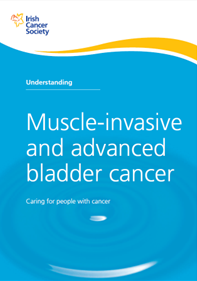Treatment for muscle-invasive bladder cancer
Chemotherapy, surgery to remove the bladder (or part of it) and radiotherapy are the main treatments for muscle-invasive bladder cancer.
How is muscle-invasive bladder cancer treated?
The main treatment options for muscle-invasive bladder cancer are:
- Chemotherapy
- Surgery to remove your bladder, or part of it
- Radiotherapy
Often people have chemotherapy to shrink the cancer, followed by surgery or radiotherapy. You may be offered a choice between surgery and radiotherapy. You may also have chemotherapy after surgery, to reduce the risk of the cancer coming back.
If surgery isn’t an option for you, the main treatment is radiotherapy, usually given along with chemotherapy (chemoradiation).
Chemotherapy for muscle-invasive bladder cancer
You may have chemotherapy drugs:
To shrink the cancer and reduce the risk of it coming back. This is called neo-adjuvant treatment.
Giving chemotherapy with radiotherapy (chemoradiation) can help to make the treatment work better.
To reduce the risk of the cancer coming back. This is called adjuvant treatment.
Often a few chemotherapy drugs are used together for muscle-invasive bladder cancer. Your doctor or nurse will discuss your treatment with you.
Surgery for muscle-invasive bladder cancer
You may have surgery to remove all or part of your bladder (radical or partial cystectomy) if you have muscle-invasive bladder cancer.
Radiotherapy for muscle-invasive bladder cancer
Radiotherapy is a treatment that uses high-energy X-rays to kill cancer cells. Radiotherapy for muscle-invasive bladder cancer may be given:
- Instead of surgery.
- Before surgery to shrink a tumour.
- After surgery to destroy any remaining tumour.
- With chemotherapy to make the treatment work better (chemoradiation).
- To relieve symptoms if the cancer is advanced or has come back. For example, pain, discomfort, bleeding or blockage.
- To treat a single spread of cancer, such as in your brain or bone.
Talk to a Cancer Nurse

Support Line
Our Daffodil Centres


